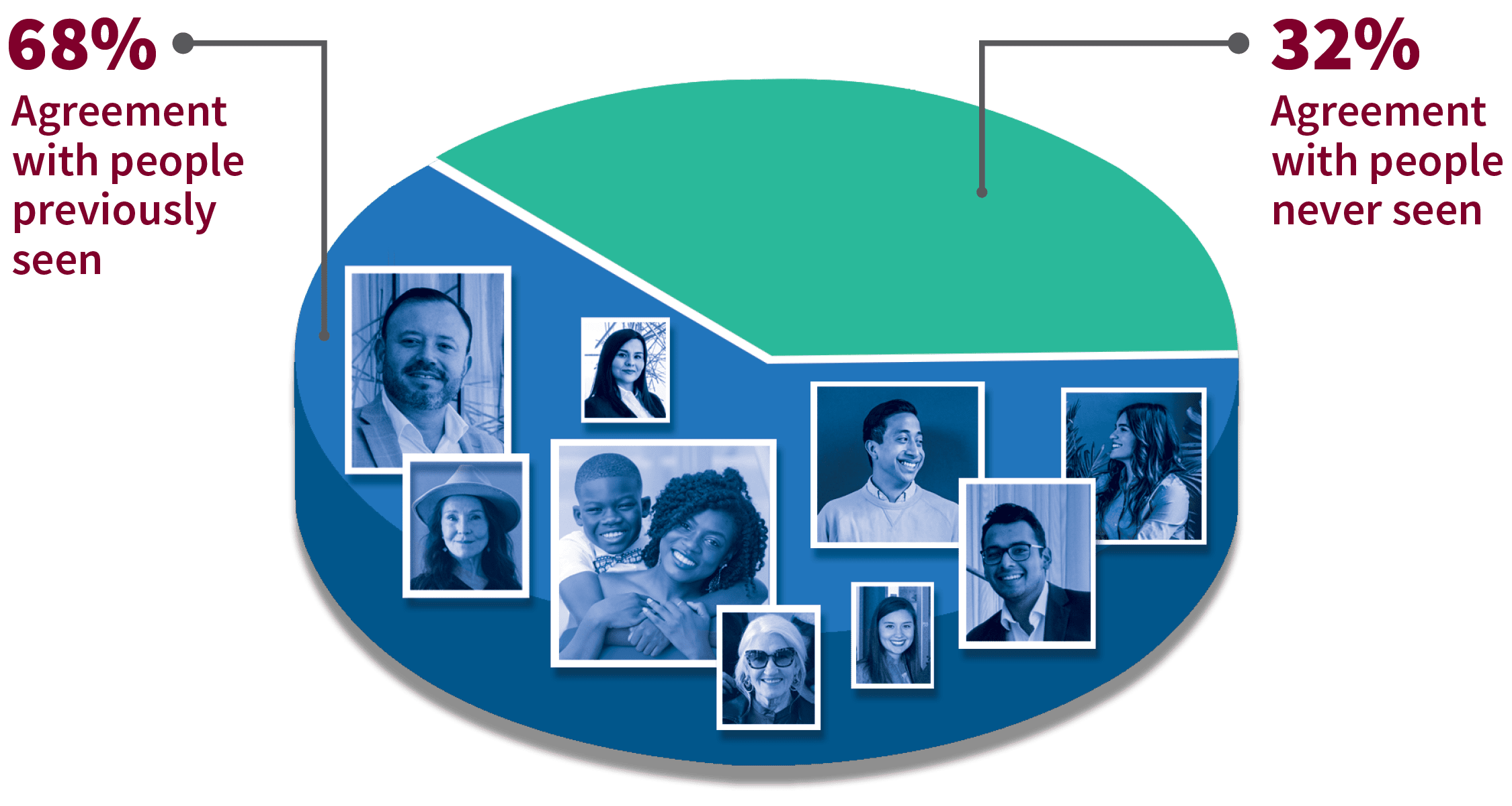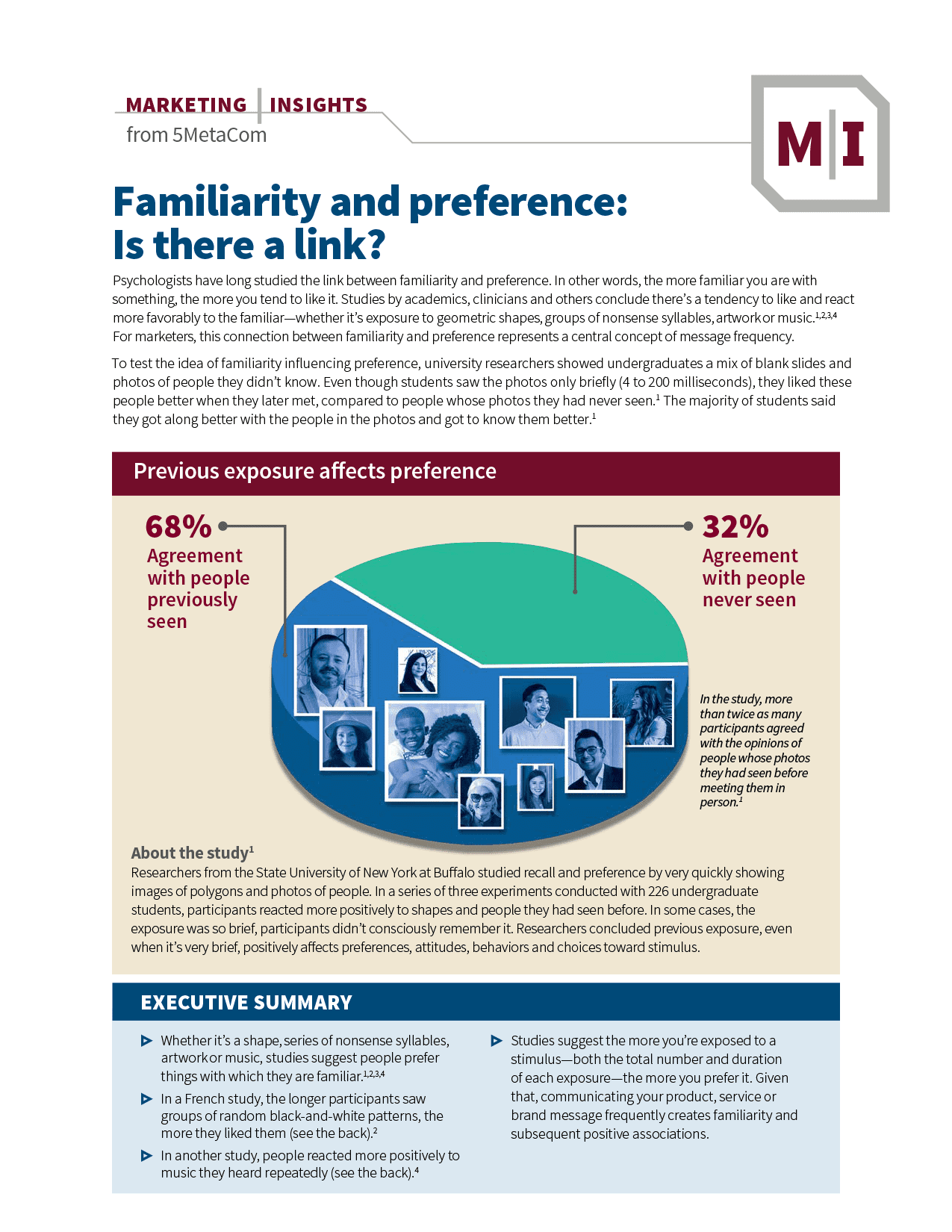Familiarity and preference: Is there a link?
Psychologists have long studied the link between familiarity and preference. In other words, the more familiar you are with something, the more you tend to like it. Studies by academics, clinicians and others conclude there’s a tendency to like and react more favorably to the familiar—whether it’s exposure to geometric shapes, groups of nonsense syllables, artwork or music.1,2,3,4 For marketers, this connection between familiarity and preference represents a central concept of message frequency.
To test the idea of familiarity influencing preference, university researchers showed undergraduates a mix of blank slides and photos of people they didn’t know. Even though students saw the photos only briefly (4 to 200 milliseconds), they liked these people better when they later met, compared to people whose photos they had never seen.1 The majority of students said they got along better with the people in the photos and got to know them better.1
Previous exposure affects preference

In the study, more than twice as many participants agreed with the opinions of people whose photos they had seen before meeting them in person.1
About the study1
Researchers from the State University of New York at Buffalo studied recall and preference by very quickly showing images of polygons and photos of people. In a series of three experiments conducted with 226 undergraduate students, participants reacted more positively to shapes and people they had seen before. In some cases, the exposure was so brief, participants didn’t consciously remember it. Researchers concluded previous exposure, even when it’s very brief, positively affects preferences, attitudes, behaviors and choices toward stimulus.
EXECUTIVE SUMMARY
- Whether it’s a shape, series of nonsense syllables, artwork or music, studies suggest people prefer things with which they are familiar. 1,2,3,4
- In a French study, the longer participants saw groups of random black-and-white patterns, the more they liked them (see the back).2
- In another study, people reacted more positively to music they heard repeatedly (see the back).4
- Studies suggest the more you’re exposed to a stimulus—both the total number and duration of each exposure—the more you prefer it. Given that, communicating your product, service or brand message frequently creates familiarity and subsequent positive associations.
The more you see something, the more you tend to like it
In several social psychology studies, researchers have noted the affect of repeated exposures on people’s attitudes and reactions. In one study, the more times people heard a particular score of music, the more positive they felt about it.4 Other studies have shown the duration of each exposure positively influences how much you like something.
The longer you see something, the more you like it

Undergraduates at the University of Bourgogne in France were shown a random pattern of black-and-white shapes. Researchers reported the longer people were exposed to the pattern each time they saw it, the more they liked it.2
What does this all mean for you?
The idea of a link existing between familiarity and preference suggests the use of frequency in your messages helps guide potential customers to liking and even preferring your products and services. These studies pose some interesting thinking, which could translate into practical relevance for marketers.
Building familiarity through message frequency
Knowing a connection exists between being familiar with something and liking or reacting more positively to it, what can marketers do? These studies suggest that solely by increasing familiarity with your company, brand or product, there’s a greater chance your customers and prospects will become receptive to, and even prefer, your offering.
How can you increase audience familiarity with your offering? By frequently exposing your audiences to a variety of messages. You can build frequency in a number of ways using several different marketing tools and mass media channels. Whether it’s advertising, direct mail or one-on-one interaction with sales reps, these studies make a strong case for frequently communicating your messages. And that’s good news for marketers.
1 Bornstein, R., Leone, D., Galley, D. (1987). The Generalizability of Subliminal Mere Exposure Effects: Influence of Stimuli Perceived Without Awareness on Social Behavior. Journal of Personality and Social Psychology, 53(6):1070-1079.
2 Reber, R., Winkielman, P., Schwarz, N. (1998, January). Effects of Perceptual Fluency on Affective Judgments. Psychological Science, 9(1):45-48.
3 Strachan, A. (2000). In the Brain of the Beholder: the Neuropsychological Basis of Aesthetic Preferences. The Harvard Brain, volume 7.
4 Kunst-Wilson, W.R., Zajonc, R.B. (1980, February). Affective Discrimination of Stimuli that Cannot be Recognized. Science, 207:557-558.
